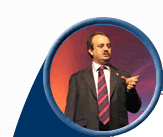Introducing the Latest Leadership Fad
Talking
© 2001 Gary S. Stager/ MagazineDistrict
Administrator
Published
in the January 2002 issue

Numerous informal and formal studies of effective teacher professional development
have asked teachers to identify the most rewarding aspects of “P.D.”
The top answer is always something like, “being able to talk with other
educators.” Talk? Do we need specific strategies to get people working
together to engage in the most basic acts of human communication? Apparently
so.
For decades creative teachers have insulated themselves from the barrage of
illogical mandates, curricular fads and punitive bureaucracies by keeping to
themselves. Teachers from coast-to-coast, silently repeat the mantra, “close
the door and teach.” This time-honored strategy causes short-term pleasure
at the expense of long-term pain. Negative trends like burnout, teacher isolation,
kids falling through the cracks, miseducative teaching practices and a diminished
sense of professionalism can result from this time-honored classroom cone of
silence. There are also missed opportunities, that include learning from colleagues,
sharing resources, peer review, enhanced professionalism, playing a role in
curriculum decisions and teachers uniting to fight for better working conditions.
Most of all, “closing the door” deprives the community of compelling
learning models. The public can’t shoulder all of the blame for the trend
of higher meaner standards, back-to-basics movements and standardized test-mania
if they have not been treated to examples of great teaching and deep child-centered
learning experiences. Without such examples, the system will continue as it
has in the past. Societal pressures, changing economy and new intellectual opportunities
make the status quo unsustainable.
Weak leadership, poor preservice teacher education and inadequate classroom
supervision may explain educational shortcomings, but abundant opportunities
for teachers to talk with one another and their administrators might be the
most powerful remedy of all. Dubious classroom practices may be looked at in
a new light when questioned by peers. More effective strategies might emerge
during ongoing collaboration and dialogue.
Administrators need to talk with one another and their teachers. Hiding in your
office under a stack of paper works against your interests and those of the
students you are employed to serve. Organizing with peers may lead to ways of
distributing your non-instructional responsibilities. You may even rebel. No
matter how irksome the tasks required of you, your first obligation is to create
rich learning environments in which communities of practice serve the children
and nurture the soul of a school.
A recent radio program in Los Angeles featured high school seniors asking questions
of Governor Roy Romer, Superintendent of the Los Angeles Unified School District.
One student asked about a “learning walk” that consisted of 15 or
so administrators in suits who descended on her class, asked invasive questions
for the length of the class and deprived her of an opportunity to learn during
that period. I love new educational euphemisms so I slowed down the car to listen
carefully for a definition of the “learning walk.” I was not disappointed.
Romer went on to explain that he believed that “learning walks” were
an effective tool for getting principals into classrooms to see what happens
in them. How the heck did we get to the point where we need central office-arranged
fieldtrips for principals to spend time in classrooms? This is indefensible.
Rather than address the problem - too much paperwork, too many meetings…
- the district has turned classrooms into petting zoos for school administrators.
If there were a hall-of-fame for Machiavellian principals, my high school leader
would surely be enshrined. His amazing innovation was managing to keep the school
from having a common teachers room for close to twenty-five years. If the teachers
can’t talk, then you can lead by divide and conquer methods.
Schools around the world often have morning tea, recess and other times during
the school-day during which teachers can get to know one another informally
and collaborate professionally. Friday happy hours are weekly affairs. Professional
development is often multi-day and away from the campus so teachers can go for
a walk or stay up all night chatting. Class cocktail parties are regularly hosted
by parents and attended by classroom teachers. These ingenious intervention
strategies do not require an act of Congress but a desire to engage others in
the learning process through dialogue.
Knowledge is socially constructed. Effective learning environments need to support
communities of practice and these communities need to talk to one another. Teachers
need to open their doors and administrators need to open channels of communication.
|

